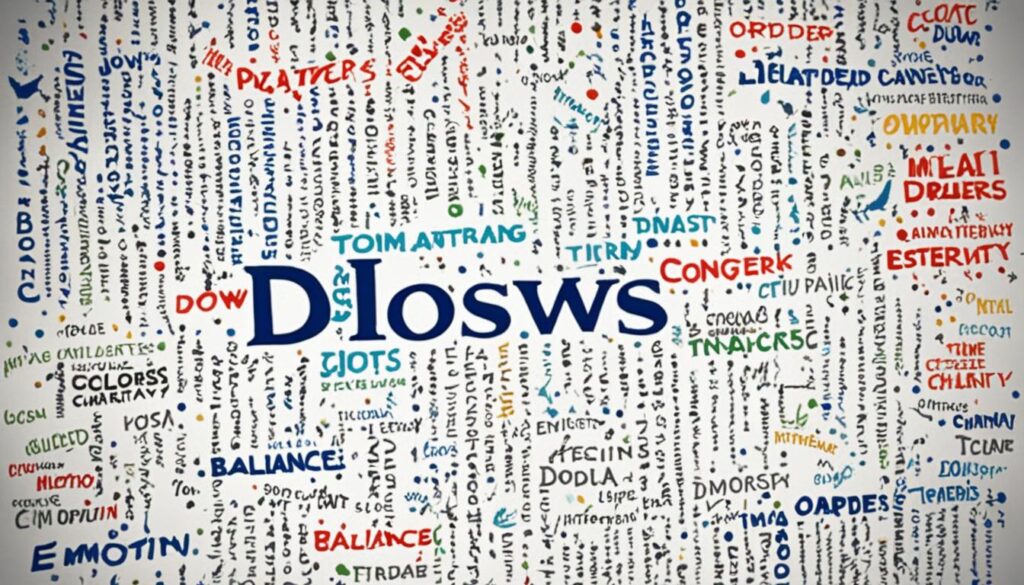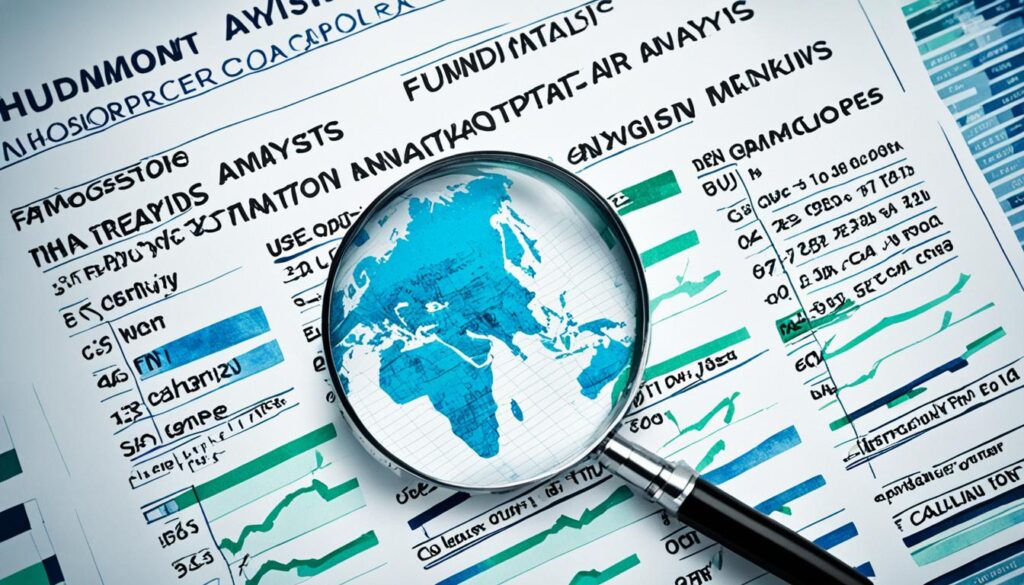What is Technical Analysis in Forex Trading?
In April 2020, the Canadian dollar fell a lot against the US dollar. This was because of the big drop in oil prices. It showed how markets are connected. It also showed how important technical analysis is in forex trading. Technical analysis uses past price charts and market data to predict future prices without looking at the economy.
Technical traders, or chartists, look at price actions closely. They use tools like moving averages and oscillators to spot trends and find good trade chances. They try to guess future prices by looking at the past. They believe history could repeat itself.
Fundamental analysis checks economic data and news. Technical analysis offers a different way to see the market. Using both can make a stronger trading plan. But, trading forex can be risky. Losses could be more than what you put in. So, knowing technical analysis well is key to doing well in this market.
Key Takeaways
- Technical analysis focuses on studying historical price charts and market statistics.
- Traders use tools like moving averages and oscillators to analyze price trends.
- The approach relies on the assumption that historical price patterns can predict future movements.
- Combining technical and fundamental analysis can create a robust trading strategy.
- Engaging in forex trading involves significant risks, requiring a thorough understanding of technical analysis.
Introduction to Technical Analysis
Technical analysis is a method used in forex trading. It looks at price charts to predict future movements. It believes the market reflects all available information, moves in trends, and past trends will repeat because of human nature.

Definition and Basics
It’s all about looking at past price data to find future trading chances. Various charts, like candlestick charts, show market feelings. This isn’t just for forex. It also works for stocks, futures, and more. Traders use many methods to be more certain about their trades.
It has become very popular recently because of better data and tools. Like thousands of strategies could be useful for different markets. Indicators such as trends and momentums help traders see patterns. They help decide when to buy or sell.
Importance in Forex Trading
Learning technical analysis is key in forex because these markets often follow trends. By studying charts, traders can make better choices based on price movements. They don’t have to rely only on news. For example, some patterns can show when a trend might change.
Bollinger Bands® are important too. They show if a currency is too expensive or too cheap. This can help predict price changes. Traders also use support and resistance lines. These show levels where prices often stop. All of this helps traders make better decisions.
| Technical Analysis Aspects | Details |
|---|---|
| Assumptions | The market discounts everything, price trends, history repeats |
| Applicability | Forex, stocks, commodities, futures, fixed-income securities |
| Popular Charts | Candlestick charts |
| Common Indicators | Trend, momentum, volatility indicators |
| Patterns | Wedge patterns, Bollinger Bands® |
The Historical Context of Technical Analysis
Technical analysis began late in the 19th century with Charles Dow’s work. He laid out the basics that many still use today. This type of analysis helps us predict where market trends are going. It’s key for anyone looking to understand stocks and trading.
Charles Dow and the Dow Theory
Charles Dow created the Dow Theory in 1885. He believed the stock market followed certain rules. This theory looks at things like price changes, how much is traded, and the time it takes for prices to change.
Dow made the Dow Jones Industrial Index. This index tracks how the market does over time. Others, like William P. Hamilton, took Dow’s ideas further. They were able to predict big market moves, like the 1929 crash.

Eventually, people like Robert Rhea used Dow and Hamilton’s work to make accurate predictions. They did this in the early 1930s. Their success helped technical analysis gain trust.
Evolution and Contributors
Over time, many added to Dow’s foundation. William P. Hamilton improved the Dow Theory after Dow. Robert Rhea carried on this work into the 20th century. Both helped make technical analysis better at predicting market trends.
Guys like Edson Gould and John Magee also made important contributions. They introduced new patterns and signals. This made technical analysis even more useful in the business of stocks and trading.
Today, technical analysis is key for folks working with commodities and the forex. They look at past price patterns to make short-term trades. They use different tools to figure out market trends. The field keeps growing with new methods and ideas. It’s all about understanding how people and markets act.
The CMT Association is a big support for market technicians worldwide. It shows how important technical analysis is today. It’s not just for looking at the past. It helps people make smart choices in today’s trading world.
Fundamentals vs. Technical Analysis
The argument between fundamental and technical analysis is as ancient as the markets themselves. Enthusiastic traders stand by either technical or fundamental analysis, often finding fault with the other’s chosen way. But understanding both can lead to a smarter investment plan.

Differences in Approach
When it comes down to it, fundamental analysis aims to find the true value of a security. It looks deep into a company’s health through its financial documents and other key info. Things like how well the leaders run the company, what stage the industry is at, and the company’s edge over others are taken into account. On the other side, technical analysis looks at past currency prices to predict future ones. It uses charts and looks for patterns in the data, along with other stats and movements. Things like Moving Averages, Bollinger Bands, and RSI are crucial for this type of analysis.
Strengths and Weaknesses
Where fundamental analysis shines is in digging deep into a company’s financial standing. It’s best for long-term strategies, helping investors know if something is a good deal or too pricey. But it can take a lot of time because it demands detailed looks at financial and economic clues.
Then there’s technical analysis, which is quick to give answers based on price and volume figures. It’s great for short-term moves in the market. This method is skilled at picking up on what the market feels and spotting trends and some key levels. But sometimes, too many people following the same indicators can create issues or inaccuracies.
A mix of technical and fundamental methods, along with an eye on market psychology, can give the best of both worlds. It can balance out their individual drawbacks. In this way, investors can make more informed choices.
Key Concepts of Technical Analysis in Forex Trading
Technical analysis in forex trading involves important ideas. These concepts help traders decide wisely. They include price action techniques and knowing forex sentiment. These insights are key to understanding market trends and spotting turning points.
Price Action Analysis
Price action analysis is vital in technical analysis. It looks at past price movements to guess future directions. Traders use these techniques to find supply and demand levels. This helps them choose when to enter or exit the market. They use tools like candlestick patterns and trend lines to see market forces.
For example, the Relative Strength Index (RSI) says the market is overbought if it goes over 70. This hints at a possible drop. The Moving Average Convergence Divergence (MACD) helps spot trends. Traders look at how its line interacts with the signal line. Tools like the Stochastic Oscillator and Fibonacci retracements are also important.
Market Sentiment
Feeling in the forex market is key for traders to understand. It shows how people feel about a currency or market trend. This info helps traders foresee market turns. Candlestick patterns, like Doji and hammer patterns, show if the market might change or keep going.
Indicators like the Bill Williams Indicator and the Relative Vigor Index (RVI) show trend strength. They help confirm market sentiment. Using these tools makes predictions better and improves trading.
Picking the right moment and analyzing charts well is crucial. Looking at daily and weekly charts helps find big trends. This is vital for good entry and exit decisions in forex trading.
Chart Patterns and Their Significance
Chart patterns are crucial in analyzing markets. They show trends, continuations, or reversals in a visual way. Traders use these to make smarter decisions in Forex. They are key for predicting future price movements.

Types of Chart Patterns
Forex traders use many chart patterns to understand where the market might go. Some important ones are:
- Head and Shoulders: It’s a big reversal sign with clear targets.
- Triangles: Seen in short-term frames, these come in different shapes and help set targets.
- Engulfing Candlesticks: They show powerful reversals and are easy to see for trades.
- Ichimoku Cloud Bounce: A pattern that uses the Ichimoku cloud for trading cues.
- Double Top: It’s used to find possible market tops or reversals.
- Rising and Falling Wedges: These predict upcoming price shifts.
- Descending Triangle: Important for spotting future market moves.
- Cup and Handle: Aids in analyzing markets for traders.
Using Chart Patterns for Predictions
Finding the right chart patterns is vital for good trading choices. When used well, these patterns offer deep insights into market trends. They help traders with important decisions like when to enter or exit a trade.
| Pattern | Type | Significance | Insights for Traders |
|---|---|---|---|
| Head and Shoulders | Reversal | Entry, Stop, Profit Target | Identifies market top or bottom |
| Triangles | Continuation | Entry, Stop, Profit Target | Foresees trend resumption |
| Engulfing Candlesticks | Reversal | Reversal Signal | Spots strong trend changes |
| Ichimoku Cloud Bounce | Continuation | Dynamic Support/Resistance | Trades in trending environments |
| Double Top | Reversal | Reversal Point | Predicts market weakness |
| Rising/Falling Wedges | Predictive | Direction, Distance | Forecasts future moves |
| Descending Triangle | Continuation | Market Insight | Anticipates trend continuation |
| Cup and Handle | Continuation | Market Analysis | Enhances trading techniques |
Learning how to spot and use chart patterns can really improve your Forex trading. It can make your strategies better and your trades more successful.
Understanding Support and Resistance Levels
Learning about support and resistance levels is key in technical analysis. It supports support resistance trading and price level analysis. Support is like a floor where prices stop dropping, then go back up. Resistance acts as a ceiling, making prices stop and turn the other way.
Traders and investors look for these levels in all kinds of charts. This includes daily, weekly, and even very short, one-minute charts. Support and resistance are found everywhere, but longer-term levels are more influential.
Support and resistance levels aren’t fixed numbers but zones. They’re influenced by how people think and past price movements. This is why they work more like areas than precise prices. Trendlines help show where these zones are by tracking trends over time.
Round numbers, like $50 or $100, often become strong barriers for prices. They’re difficult for prices to cross because traders pay a lot of attention to them.
The roles of support and resistance can switch. After a rise, the top before a drop becomes a resistance level. If the price breaks through this level, it might support the price’s next move up. Likewise, a fall followed by a rise sets a support level. This breaks if the price then drops below, making it a barrier.
- Support and resistance that the price tests often without breaking shows its strength.
- The force of a price move once a support or resistance is broken depends on how strong it was.
Prices are always creating new support and resistance levels. Price level analysis helps traders find optimal points to enter and exit trades. This is critical for managing risk and making successful trades. Knowing these levels well, through historic data or using tools like moving averages, is vital for anyone in the forex market.
The Role of Trend Lines and Moving Averages
In forex trading, trend lines and moving averages help a lot. A trend line connects highs or lows to show trend direction. They’re key in spotting trends and guiding decisions.
Moving averages smooth out price data to highlight market trends. They cut out the noise. Traders lean on simple or exponential moving averages for insights.
20,000+ traders lean heavily on these trends in forex. They’re known for showing trend changes and key reversal points.
Different plans suit various investment levels. The Basic Plan, with a $300 deposit, offers 5-25% monthly returns. The Plus Plan’s $5,000 deposit returns 8-28% monthly, plus a 3% referral bonus. For the Premium Plan’s $50,000 deposit, it’s 10-35% monthly with a 5% referral bonus. Plans include features like VPS at a set price.
| Plan Type | Deposit Range | Monthly Profit Range | Fee Structure | Referral Profit |
|---|---|---|---|---|
| Basic Plan | $300 – $1,000 | 5-25% | $17 monthly | None |
| Plus Plan | $5,000 – $30,000 | 8-28% | 0.7% deposit monthly | 3% |
| Premium Plan | $50,000 – $500,000 | 10-35% | 0.5% deposit monthly | 5% |
To learn more about how trend lines and moving averages work in trading, check out detailed trend analysis guides and education materials.
Oscillators and Momentum Indicators
In the world of technical analysis, oscillators and momentum indicators are key. They help measure the quickness of price movements and can show when these movements might change. These tools are especially good at spotting times when a certain market is either overbought or oversold in terms of its assets.
By checking how fast prices are changing, these indicators offer a peek into where the market might go next. This can be really helpful for traders looking to time their moves more accurately.
Common Oscillators Used
Popular oscillators include the Relative Strength Index (RSI), Stochastic Oscillator, Rate of Change (ROC), and Money Flow Index (MFI). They are shown on a scale of 0 to 100.
Numbers above 70-80% often suggest that a market is overbought. While figures below 30-20% hint that it could be oversold. However, their readings may not always be right during particularly sharp price changes.
To make them more reliable, many traders combine these oscillators with other tools. For example, mixing them with moving averages can give a clearer picture of the market’s general direction. Using these combinations can improve trading decisions.
Interpreting Momentum
Momentum trading looks at these indicators to spot strong trends. For example, the RSI and Stochastic Oscillator might indicate when to buy or sell by signaling slowdowns.
It’s important to know that oscillators work better when markets are moving sideways. They are also more useful when used with indicators that can pick up on overall trends. By understanding how these tools interact, traders can be smarter about their decisions in the forex market.
